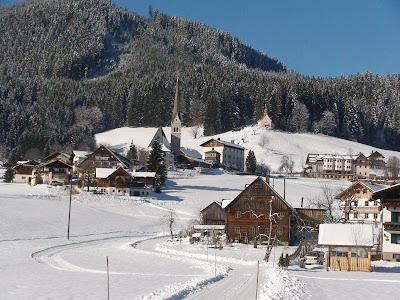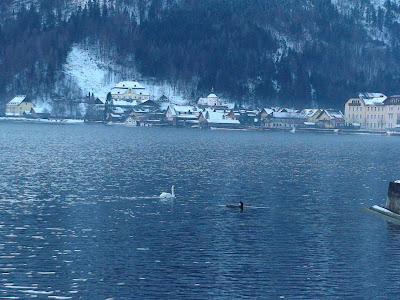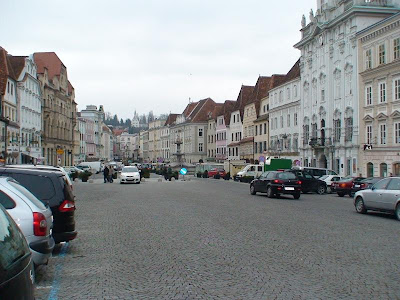Hard Zell, and the Road Through the Lakes
There is not much to tell about the road between Kitz and Zell, other than that all went well. Of course there was spectacular mountain scenery, frozen waterfalls, huge icicles hanging from cliffs, and a slate-grey ‘sea’ as we got to Zell am See. But alas, after what we had seen before, we had become a bit blasé about sights that we would have seen as ‘spectacular’, had we come straight from Vienna's airport in the dead of night! It would be, I imagine, like going to a parade of all the world’s Angelina Jolie look-alikes, being enthralled for the first few dozen, but then being less impressed when number 37 walked down the cat-walk, even if it was Angelina herself!
Now Zell’s main attraction, is its superb location on the peanut-shaped Zeller See (Sea), surrounded by very high, snow-covered mountains. Yet when we arrived, there was a low and icy cloud over the city, and poor Zell looked like Mona Lisa without her smile. We parked near the landmark Grand Hotel, which rests on the Sea’s edge and looks just as pristine as it did when it opened in 1894, and people arrived by steamboat. Indeed, only a year before its opening, Emperor Franz Joseph had made an inaugural visit to what remains the second biggest city in Salzburg State, after Salzburg itself. Zell was declared to be a market town in the fourteenth century, and has continued to thrive ever since, and became a city in 1928. Now it thrives on tourism and its year round appeal for winter sports, summer hiking, and yachting. As in Kitzbuhel, the ski lifts operate virtually from the heart of the city. There are some fine buildings, lots of cobbled streets and interesting alleyways with numerous outdoor après-ski bars where you stand in your ski gear and drink beer, wine and schnapps, while eating a warm pretzel or ‘hot dog’. And as in Kitz, Zell is a place where the young are in abundance.
We found our way to the four-star Fisherwirt Hotel in one of the main streets, although I lingered in front of a shop window full of cured ham, salami and big squares of dressed spek. There were cheeses too, and herbal drinks, as well as firewater concoctions, all rather inviting and beautifully displayed. Our hotel was rather 60’s four star, full of dark wood panelling and a bathroom which looked as though it was straight from ‘Leave it to Beaver’! Up above the two single beds, there was a ladder to a loft, for kids, or a bevy of Playmates. We spent little time in the room, but wandered in the streets of Zell till the nagging cold pushed us into a nearby restaurant for the usual wholesome filling. Later, as we lay in our beds, it appeared that the young at a nearby bar, were moved to song, again and again, happy skiers no doubt, who in some time-warp kept singing My Bonnie Lies over the Ocean. Maybe that was the only song they all knew, or maybe it was a Beatles revival night, but after the fourth spasm, I wished indeed, that they were over the ocean! Then to cap it off, the next morning, I am sure that a woman who was a former Hitler Youth leader, told us once again, that we were sitting at the “vrong tapel’, and castigated us in no uncertain terms, even though the dining room had what appeared to us to have free seating! Just to spite her, I spilled big dollops of my Coco Pops and Bircher-meusli, all around my plate and I could see her thinking “Ahhh, those English!”
From Zell, which clearly we didn’t see too well, TomTom again steered us towards autobahns, but this time we would have none of it, and we followed back-roads till we reached Werfen and its famous Hohenwerfen Castle, the setting for the movie Where Eagles Dare. We turned off at Golling, and headed for Gosau, down a dark narrow valley. I have now seen Gosau in its summer garb, and its winter coat, and I still cannot say which is the more beautiful, because both are simply stunning. The Gosausee, so blue and dancing then, was now frozen over, while in the distance, the Gosau glacier glistened. On this windless, sunny day, when a hot air balloon took off and flew over the landscape, I confess to being jealous. From 'up there', the view, to say nothing of the Minus Three temperature, would have taken my breath away!

Gosau, on a perfect winter’s day
We followed another deep valley to the little town of Hallstatt, on the Hallstatter See, and because the mountains loom over the town and strangle any sunlight, it is also reputed to be one of the coldest spots in an Austrian winter. Hallstatt hugs the shoreline like an orange peel the fruit, and its railway station is across the ‘sea’, so that most romantically, you approach it by boat. Once it was a most important town because of its salt-mines, and today you can still visit the salt mine and slide down the slopes on your bum in a conga-line from one cavern to another. The mine, like much of the rest of the town, is closed in winter, and we were lucky to find the Seehotel Gruner Baum (Green Tree) with its restaurant open. Three waiters and a chef watched us eat, while we in turn looked at the lake and a pair of swans which looked serene, even though the water temperature must have been just above freezing. Later we found our little gasthof, the comfortable Gruner Anger (Green Patch) although as far as the temperature was concerned everything looked blue, not green!
With the sun shining everywhere else but in Hallstatt, we headed off in search for warmth in the nearby town of Bad Aussee, and being good Aussies, we both had our picture taken at the sign announcing the town limits. If only we had bought one of those tee shirts that says “There are no kangaroos in Austria”, it would have made a perfect Aussie picture! Interestingly, there were many people in town who wore traditional Austrian dress, not lederhosen mind you, as it was hardly the season, but felt coats with rounded collars and an abundance of buttons, and a felt hat with suitable plumage. They also boldly stepped on to crosswalks, with nary a glance sideways, but a ‘death stare’ at the driver if you had to brake hard. People know their rights in Austria!

The Cold Hallstatter See, and the town that hugs the shoreline
We drove on to Bad Ischl, a favourite town of the Emperor Franz Joseph, and many summers in his 60 year reign, were spent there. It seems that his ‘mum’ just couldn’t get pregnant until she ‘took the waters’ at Bad Ischl, and hey presto, out popped the “Salt Princes” (There was lots of salt in the water, you see!), FJ and his brother! You recall pictures of FJ don’t you? All ruddy faced, with rheumy eyes, mutton-chops and twirled moustache, and fond of uniforms and hats! Later, his mum, the Arch-Duchess Sophie, gave FJ a villa (In Hapsburg yellow of course, like all their properties) and he and his wife, Princess Elizabeth, better known as Sisi, were frequent visitors to the Kaiservilla. So too was FJ a visitor to a nearby house, where he installed his mistress, Katharina! No wonder FJ called Bad Ischl, “His Heaven on Earth”! FJ signed the declaration of war against Serbia at the Kaiservilla in 1914, and soon, WWI followed. The noted composer, Franz Lehar of “The Merry Widow” fame also lived in Bad Ischl and the town has always had a wonderful concert and opera atmosphere. We found the Café Sisi in a building shaped like a rounded ships prow, full of Corinthian columns and painted ceilings, and a bar that looked straight out of a Renoir painting. It looked decidedly and grandly, “Hapsburgian” and certainly Emperor-ish, but I could find no evidence of a connection. Maybe it had been quietly built for his mistress, and furnished in a manner to make FJ feel right at home!
Snow loomed as we left Hallstatt, and we skirted the haunting Trauensee, and drove to Gmuden and on to Steyr, through rolling countryside where snow was absent from a lot of fields. Steyr this year celebrated its 1030 year birthday and has some of the finest Gothic architecture in Austria.

The ancient Stadplatz (main square) of Steyr. Much of it was rebuilt after WWII bombing.
Its setting, on the confluence of the Rivers Steyr and Enns, has long made it a major manufacturing centre for armaments (The Steyr 'Bullpup' rifle is the main infantry weapon of many armies), heavy diesel engines, cars, trucks and tractors and consequently, was heavily bombed during WWII. The ultimate architect of that bombing, Adolf Hitler, lived in Steyr at the beginning of the Twentieth Century, and the Russian and American forces met there in 1945. Interestingly, it is today twinned with Bethlehem. Steyr has a wonderful array of old churches and the over-bearing Lamberg Castle, from which run cobbled streets and ivy covered passageways, and steps down to the Stadplatz. All over Castle Hill there are lovely old houses with sturdy wooden doors and carved portals. It was market day while we were there, so the aroma of meats and cheeses hung in the grey air, and made the coffee taste extra special. It would take much to make me tire of Steyr, but the snow had started, and we still had a few hours to get to Vienna.
We joined the main A1 autobahn in driving snow, and while we saw a number of snow-ploughs travelling in unison one a hundred metres behind the other to fully sweep the road, the snow piled up and became slushy. Yet the Austrian motorists sped on through the whiteout conditions, with all the faith of a Muslim, while we were happy to just plod along in the truck lane! The snowing had stopped by the time we reached Vienna, but it had already had its dumping there. Once again, everything was 'marshmallow-topped', soft and beautiful. If only it didn't have to melt!
Winfred Peppinck is the Tales of the Traveling Editor for Wandering Educators


















